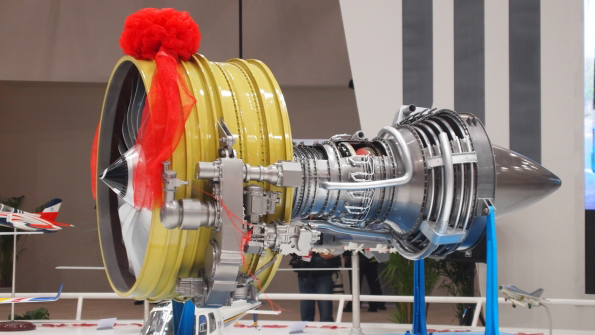Phone: +86 21 51559030
contact@galleon.cc
AECC Aims At Near-Leap-1C Performance For Its Engine
Oct 16,2018

SHANGHAI¡ªAero Engine Co. of China (AECC), developing the CJ-1000 turbofan for the Comac C919 airliner,is aiming at what it believes is a specification only slightly inferior to those of rival engines.
Thrust-specific fuel consumption in cruise for the initial version of the engine, the CJ-1000A, will be 0.53 lb. per
lb. of thrust per hour, according to details issued by Galleon, a Chinese conference organizer. Galleon has
published the information in a brochure for an aero-engine conference to be held May 24-25 at Shenyang,
China. AECC, which is supporting the conference, is evidently Galleon¡¯s source.
For the CFM Leap-1C, the only engine available for the C919 until the CJ-1000 is ready, cruise fuel consumption
is 0.5 lb. per lb. per hour, Galleon says. Again, the conference organizer must be relying on information from
AECC.
The PW1100G of the AirbusA320 neo family has the same cruise fuel consumption as the Leap-1C, in AECC¡¯s
estimation. Engineers working on the CJ-1000 have previously said they needed to match the CFM Leap-1C,
because they were working to the same propulsion specification set by Comac.
The CJ-1000A is intended to generate takeoff thrust of 28,200 lb. A timeline suggests the two-shaft, ungeared
turbofan will go into production in 2022.
Foreign engineers doubt that the CJ-1000A can be developed in anything like the published schedule. The
Chinese industry has negligible experience in developing commercial engines, let alone one that is supposed to
go head-to-head with two of the latest products from Western manufacturers.
The second version of AECC¡¯s turbofan, the CJ-1000B, is scheduled to follow in 2026 with a thrust of 30,800 lb.
thrust and cruise fuel consumption of 0.52 lb. per lb. per hour.
Bypass ratio for the CJ-1000A will be greater than nine. The overall pressure ratio is intended to be about 40,
while noise should be 15 PENdB below the FAA¡¯s Stage 4 requirement.
AECC is designing its engine for a turbine inlet temperature of 1,577 C (2,871 F) and nitrogen oxide emissions
more than 50% below the CAEP 6 requirement of the International Civil Aviation Organization.
AECC was formed in 2016, mostly by splitting off the engine units of Avic. The CJ-1000 is a project of a
Shanghai subsidiary, AECC Commercial Aircraft Engines, formerly Avic Commercial Aircraft Engines.
The manufacturer expects a production run of 1,670 CJ-1000s, including 124 as spares, according to Galleon¡¯s
brochure. That implies that 773 C919s will use the engine.
